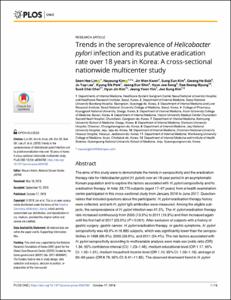KUMEL Repository
1. Journal Papers (연구논문)
1. School of Medicine (의과대학)
Dept. of Internal Medicine (내과학)
Trends in the seroprevalence of Helicobacter pylori infection and its putative eradication rate over 18 years in Korea: A cross-sectional nationwide multicenter study
- Keimyung Author(s)
- Lee, Ju Yup; Park, Kyung Sik
- Department
- Dept. of Internal Medicine (내과학)
- Journal Title
- PLoS One
- Issued Date
- 2018
- Volume
- 18
- Issue
- 10
- Abstract
- The aims of this study were to demonstrate the trends in seropositivity and the eradication therapy rate for Helicobacter pylori (H. pylori) over an 18-year period in an asymptomatic Korean population and to explore the factors associated with H. pylori seropositivity and its eradication therapy. In total, 23,770 subjects (aged 17±97 years) from a health examination center participated in this cross-sectional study from January 2016 to June 2017. Questionnaires that included questions about the participants' H. pylori eradication therapy history were collected, and anti-H. pylori IgG antibodies were measured. Among the eligible subjects, the seroprevalence of H. pylori infection was 41.5%. The H. pylori eradication therapy rate increased continuously from 2005 (13.9%) to 2011 (19.3%) and then increased again until the first half of 2017 (23.5%) (P < 0.001). After exclusion of subjects with a history of gastric surgery, gastric cancer, H. pylori eradication therapy, or gastric symptoms, H. pylori seropositivity was 43.9% in 16,885 subjects, which was significantly lower than the seropositivities in 1998 (66.9%), 2005 (59.6%), and 2011 (54.4%). The risk factors associated with H. pylori seropositivity according to multivariable analysis were male sex (odds ratio (OR) 1.34, 95% confidence interval (CI): 1.23±1.46), medium educational level (OR 1.17, 95% CI: 1.05±1.31), medium household income level (OR 1.10, 95% CI: 1.03±1.19), and age of 60±69 years (OR 8.78, 95% CI: 6.41±11.85). The observed downward trend in H. pylori seroprevalence and increase in H. pylori eradication over the 18-year period will affect upper gastrointestinal disorders in South Korea.
- Publisher
- School of Medicine (의과대학)
- Citation
- Hyun Jin Kim et al. (2018). Trends in the seroprevalence of Helicobacter pylori infection and its putative eradication rate over 18 years in Korea: A cross-sectional nationwide multicenter study. PLoS One, 18(10), e0204762–e0204762. doi: 10.1371/journal.pone.0204762
- Type
- Article
- ISSN
- 1932-6203
- Source
- https://journals.plos.org/plosone/article?id=10.1371/journal.pone.0204762
- Appears in Collections:
- 1. School of Medicine (의과대학) > Dept. of Internal Medicine (내과학)
- 파일 목록
-
-
Download
 oak-2018-1670.pdf
기타 데이터 / 5.52 MB / Adobe PDF
oak-2018-1670.pdf
기타 데이터 / 5.52 MB / Adobe PDF
-
Items in Repository are protected by copyright, with all rights reserved, unless otherwise indicated.